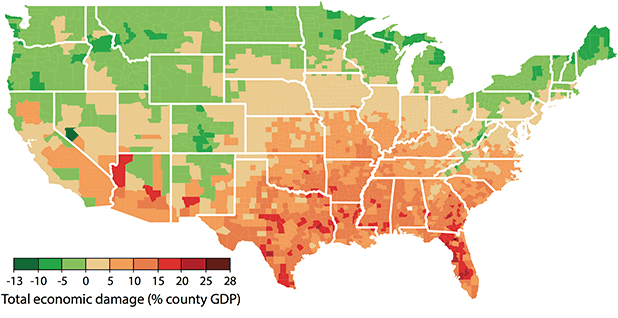I received some great feedback on the post I sent out last week about the possibility of a fee on carbon. The following is a great summary of what I heard.
Just flagging that a carbon tax unless set extraordinarily high – likely drives little progress outside of the power sector, e.g. in bldgs, transport and industry. And with coal only 20% of US carbon emissions these days (oil and gas about 40% each) we need policy that drives oil and gas out of the system just like we are doing with coal. Carbon tax won’t do that in the ranges anyone is talking about. That is why API is “considering it”
Standards. Zero emission standards for vehicles, appliances, new electric generation, new boilers, and we start closing in on carbon free economy. When your gas water heater breaks your only choice should be efficient, similar or lower price electric water heater- because consumers will not be thinking about tiny increment of carbon tax on their gas bill.
My two cents.
This certainly makes sense. Seems to me, we should have BOTH! A meaningful carbon fee (with an equitable distribution/rebate) and standards. We need to use every tool in our toolbox to drive the changes we need in a time period that will make a big difference.
Before I move on to a related topic, I want to delineate that it used to be sacrilege to even suggest a gas tax or fee on carbon (one in the same). With the growing acceptance that it is possible and advisable we can move on to how much it should be and how to equitably create it.
To me, that’s BIG progress.
Meanwhile, I don’t think that oil industry executives are getting the message. They apparently want to continue to believe that fossil fuels will continue to be relevant and in high demand for another couple of decades or more. Not sure where they plan to get financing, insurance or customers.
“Chevron Corp. said yesterday oil and gas will remain the oil major’s “core domain” over the next 10 to 20 years”
While the Chevron CEO also said this:
“By 2028, Chevron pledged to reduce the carbon intensity of its upstream oil and business by a combined 35% from 2016 levels, with a 50% cut for methane intensity.”
In practically the same breath he said this:
“the company’s CEO and chairman of the board, said the world will be using more oil and gas in the future than it does today”
Commentary reacting to the above quoted in the article I believe gets it right.
“”Chevron is misleading their investors and the public by promising reductions in ’emissions intensity’ per barrel of oil or gas, while signaling elsewhere an expansion of drilling in the Permian Basin and leaving open the door to overall increases in climate and health pollution,” Eisenfeld said. “Chevron cannot have its cake and eat it too.””
Speaking for myself, it seems to me that the fossil fuel industry executives, board directors and the industry in general would be better off accepting that if they want to be part of the solution and not part of the problem and have half a chance of survival, they would not only accept the inevitable but work to achieve it. They should pivot and look at themselves as an energy company and use the resources that they still have to lead the world in the transition to renewable energy. Otherwise they’re toast. And if they are right about the future of oil and gas, then WE’RE all toast.
To think more about a carbon fee, here’s a great article that lays out some of the current thinking.
https://www.vox.com/energy-and-environment/2020/8/17/21370732/carbon-tax-simple-useful-nt2nz
Here’s a key quote from the article:
“The climate situation is simple: either the world reaches net-zero carbon emissions or global temperatures keep rising forever. Every nation must reach net zero; the only choice is how fast.”
Chevron CEO Talks Carbon Price, Outlines CO2 Plan
Carlos Anchondo, E&E Reporter
March 10, 2021
Chevron Corp. said yesterday oil and gas will remain the oil major’s “core domain” over the next 10 to 20 years as it released new plans to reduce its carbon footprint.
In a report, the company said it plans to spend approximately $2 billion through 2028 on carbon reduction projects.
Chevron also committed to eliminating routine flaring by 2030, a goal shared by the World Bank, and set new targets to curb emissions intensity — or emissions released per unit produced — for methane and carbon dioxide. By 2028, Chevron pledged to reduce the carbon intensity of its upstream oil and business by a combined 35% from 2016 levels, with a 50% cut for methane intensity.
Mike Wirth, the company’s CEO and chairman of the board, said the world will be using more oil and gas in the future than it does today, but added that the California-based company intends “to be one of the very best, one of the most responsible, one of the lowest-carbon oil and gas” firms.
“For us to step away from what we’re really good at — for us to step away from what we might be one of the best in the world at and leave that to others to do — I don’t think is something that’s good for the trajectory towards a lower-carbon future,” said Wirth, speaking at Chevron’s virtual investor day yesterday. “And I don’t think it’s good for our shareholders for us to step away from our core strengths.”
While oil and gas will remain Chevron’s core business in the near term, Wirth said technologies like carbon capture and hydrogen are likely to be a bigger part of the company’s portfolio in the coming decades. Last week, for example, the company announced plans to build a biomass carbon capture plant roughly 40 miles west of Fresno, Calif., with companies including Microsoft Corp. and Schlumberger Ltd. (Energywire, March 5).
In the past, a focus by oil companies on emissions intensity — rather than absolute emissions — has drawn sharp rebukes from environmental groups (Energywire, Oct. 20, 2020).
Josh Eisenfeld, a corporate accountability campaigner at Earthworks, took aim at Chevron’s intensity targets in a statement yesterday.
“Chevron is misleading their investors and the public by promising reductions in ’emissions intensity’ per barrel of oil or gas, while signaling elsewhere an expansion of drilling in the Permian Basin and leaving open the door to overall increases in climate and health pollution,” Eisenfeld said. “Chevron cannot have its cake and eat it too.”
Yet Chevron said it “exceeded its 2023 upstream carbon intensity reduction targets three years ahead of schedule.” The company’s current carbon intensity is “well below industry average,” Wirth said.
“We have reported our data on a 100% basis, whether we operate or not, because just as we account for profit from every barrel, we think we should account for carbon from every barrel and not exclude things simply because we’re a non-operator,” Wirth said.
“It’s a very complete inventory of our Scope 1 and Scope 2 emissions,” he said, referring to the company’s direct emissions and those from imported electricity and steam.
Scope 3 and carbon prices
According to its report, Chevron addresses Scope 3 emissions — or indirect emissions produced through the combustion of its products by consumers — in three ways, including by “supporting a price on carbon through well-designed policies” and by “enabling customers to lower their emissions through increasing renewable products, offering offsets, and investing in low-carbon technologies.”
Wirth also fleshed out his views on a price on carbon. Chevron previously signed the Vatican’s statement on carbon pricing, which calls for governments to work together on emissions reduction policies (Energywire, Feb. 13).
“We’ve been careful not to sign on to a particular proposal yet because we’ve got a whole series of attributes that we think are a part of well-designed and sound carbon pricing policy that we would like to see,” Wirth said.
“If there were to be a proposal brought forward that doesn’t reflect broad-based application across the economy, balanced and kind of equitable step-up of the carbon price, transparency so the consumers know the impact — you know, these are things that matter, and we would work hard to get those in,” he added.
He noted that the company operates in many places where there is a price on carbon reflected in Chevron’s capital allocation, adding that “all of our planning includes a price on carbon.”
Sean Comey, a Chevron spokesperson, said that while the company has backed “well-designed, market-based mechanisms” to lower carbon emissions for a while, it was in 2019 that Chevron began to describe its support specifically as a price on carbon.
Earlier this month, The Wall Street Journal first reported that the American Petroleum Institute is weighing whether it will support carbon pricing (Energywire, March 2).
Comey added that it’s “critical that markets incentivize the most efficient and least carbon-intensive producers to provide oil and gas.”
“Such an approach may not result in each individual company reaching net zero, but it is, we believe, the most promising path toward the ultimate goal of global net zero,” Comey said.



